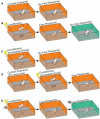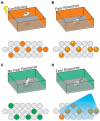Neuronal Ensembles Organize Activity to Generate Contextual Memory
- PMID: 35368306
- PMCID: PMC8965349
- DOI: 10.3389/fnbeh.2022.805132
Neuronal Ensembles Organize Activity to Generate Contextual Memory
Abstract
Contextual learning is a critical component of episodic memory and important for living in any environment. Context can be described as the attributes of a location that are not the location itself. This includes a variety of non-spatial information that can be derived from sensory systems (sounds, smells, lighting, etc.) and internal state. In this review, we first address the behavioral underpinnings of contextual memory and the development of context memory theory, with a particular focus on the contextual fear conditioning paradigm as a means of assessing contextual learning and the underlying processes contributing to it. We then present the various neural centers that play roles in contextual learning. We continue with a discussion of the current knowledge of the neural circuitry and physiological processes that underlie contextual representations in the Entorhinal cortex-Hippocampal (EC-HPC) circuit, as the most well studied contributor to contextual memory, focusing on the role of ensemble activity as a representation of context with a description of remapping, and pattern separation and completion in the processing of contextual information. We then discuss other critical regions involved in contextual memory formation and retrieval. We finally consider the engram assembly as an indicator of stored contextual memories and discuss its potential contribution to contextual memory.
Keywords: contextual fear conditioning; entorhinal cortex; hippocampus; memory engram; neural circuits.
Copyright © 2022 Marks, Yokose, Kitamura and Ogawa.
Conflict of interest statement
The authors declare that the research was conducted in the absence of any commercial or financial relationships that could be construed as a potential conflict of interest.
Figures




Similar articles
-
Loss of Ensemble Segregation in Dentate Gyrus, but not in Somatosensory Cortex, during Contextual Fear Memory Generalization.Front Behav Neurosci. 2016 Nov 7;10:218. doi: 10.3389/fnbeh.2016.00218. eCollection 2016. Front Behav Neurosci. 2016. PMID: 27872586 Free PMC article.
-
Complementary roles of differential medial entorhinal cortex inputs to the hippocampus for the formation and integration of temporal and contextual memory (Systems Neuroscience).Eur J Neurosci. 2021 Oct;54(8):6762-6779. doi: 10.1111/ejn.14737. Epub 2020 May 2. Eur J Neurosci. 2021. PMID: 32277786 Free PMC article. Review.
-
Driving and regulating temporal association learning coordinated by entorhinal-hippocampal network.Neurosci Res. 2017 Aug;121:1-6. doi: 10.1016/j.neures.2017.04.005. Epub 2017 May 5. Neurosci Res. 2017. PMID: 28483587 Review.
-
Nucleus Reuniens Is Required for Encoding and Retrieving Precise, Hippocampal-Dependent Contextual Fear Memories in Rats.J Neurosci. 2018 Nov 14;38(46):9925-9933. doi: 10.1523/JNEUROSCI.1429-18.2018. Epub 2018 Oct 3. J Neurosci. 2018. PMID: 30282726 Free PMC article.
-
Elevation of Hippocampal Neurogenesis Induces a Temporally Graded Pattern of Forgetting of Contextual Fear Memories.J Neurosci. 2018 Mar 28;38(13):3190-3198. doi: 10.1523/JNEUROSCI.3126-17.2018. Epub 2018 Feb 16. J Neurosci. 2018. PMID: 29453206 Free PMC article.
Cited by
-
Spatially Resolved Transcriptomic Signatures of Hippocampal Subregions and Arc-Expressing Ensembles in Active Place Avoidance Memory.bioRxiv [Preprint]. 2024 Feb 16:2023.12.30.573225. doi: 10.1101/2023.12.30.573225. bioRxiv. 2024. Update in: Front Mol Neurosci. 2024 Oct 31;17:1386239. doi: 10.3389/fnmol.2024.1386239. PMID: 38260257 Free PMC article. Updated. Preprint.
-
Connectivity of the neuronal network for contextual fear memory is disrupted in a mouse model of third-trimester binge-like ethanol exposure.Alcohol Clin Exp Res (Hoboken). 2025 Feb;49(2):315-331. doi: 10.1111/acer.15503. Epub 2024 Dec 13. Alcohol Clin Exp Res (Hoboken). 2025. PMID: 39672678 Free PMC article.
-
Dissecting cell-type-specific pathways in medial entorhinal cortical-hippocampal network for episodic memory.J Neurochem. 2023 Jul;166(2):172-188. doi: 10.1111/jnc.15850. Epub 2023 May 30. J Neurochem. 2023. PMID: 37248771 Free PMC article. Review.
-
Understanding Others' Distress Through Past Experiences: The Role of Memory Engram Cells in Observational Fear.Adv Neurobiol. 2024;38:215-234. doi: 10.1007/978-3-031-62983-9_12. Adv Neurobiol. 2024. PMID: 39008018 Review.
-
Object-translocation induces event coding in the rat hippocampus.Commun Biol. 2025 May 24;8(1):797. doi: 10.1038/s42003-025-08241-2. Commun Biol. 2025. PMID: 40413308 Free PMC article.
References
-
- Almada R. C., Albrechet-Souza L., Brandao M. L. (2013). Further evidence for involvement of the dorsal hippocampus serotonergic and gamma-aminobutyric acid (GABA)ergic pathways in the expression of contextual fear conditioning in rats. J. Psychopharmacol. 27 1160–1168. 10.1177/0269881113482840 - DOI - PubMed
-
- Amaral D., Lavenex P. (2007). “Hippocampal neuroanatomy,” in The Hippocampus Book, eds Anderson P., Morris R., Amaral D., Bliss T., O’Keefe J. (New York, NY: Oxford University Press; ), 37–109.
Publication types
LinkOut - more resources
Full Text Sources

